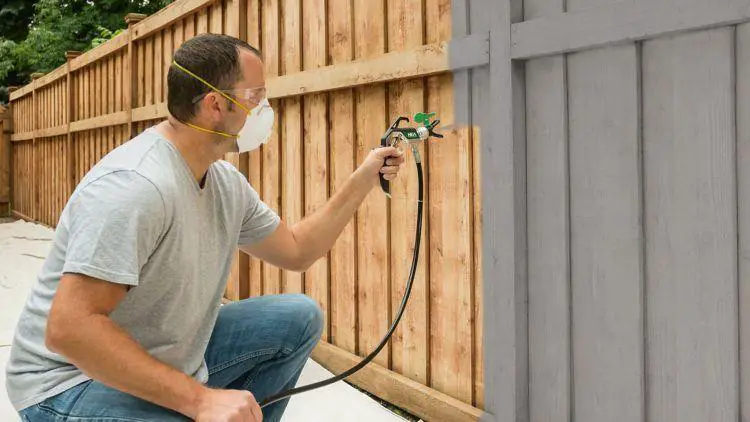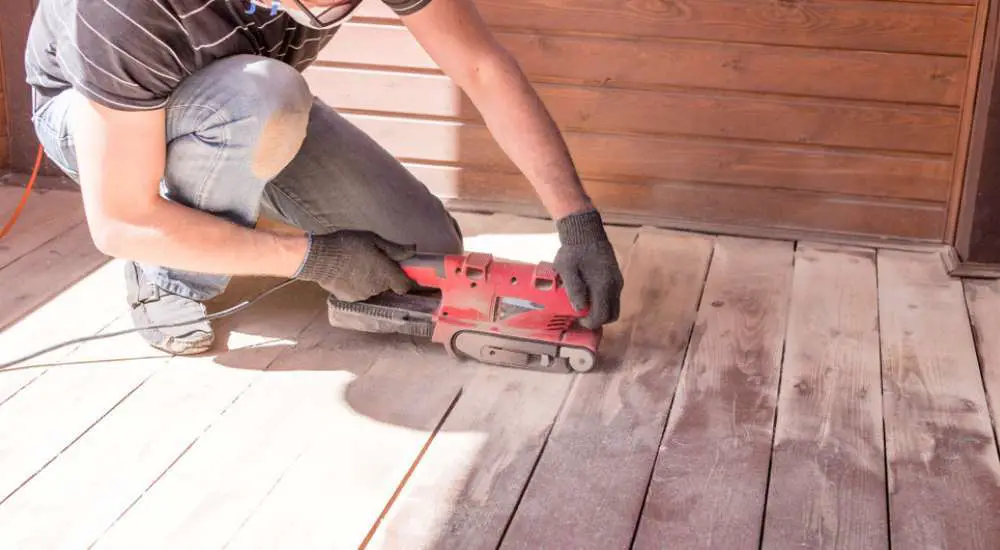Do you want to improve the lifespan of your old fence? Well, did you know that an ancient wood fence can gain a lot from applying a wood stain? Understanding how to stain an old fence will give you a fresh look and protect it from rotting.
A high-quality oil-based wood stain will help you boost the aesthetics of your home by giving your old wooden fence an impressive look. Note that oil-based wood stain slows down the growth of mildew and decreases the rate of rotting. You will, therefore, get a long-lasting wood fence that is always in style all year round.
How to apply wood stain to an old fence, therefore, becomes quite a critical question. Today, I will walk you through the step-by-step process of adding wood stain to your old wooden fence. The good news is that the process is rather simple and straightforward with this guide.

Contents
- 1 Choosing the Right Stain
- 2 Explanation of what staining is and how it works
- 3 Types of stains and their uses
- 4 Step-by-Step Instructions
- 5 Post-Staining Maintenance
- 6 Troubleshooting Common Problems
- 7 FAQ’s
- 7.1 Do I need to clean the fence before staining it?
- 7.2 How often should I stain my fence?
- 7.3 Do I need to remove old stain before applying a new one?
- 7.4 What type of stain is best for an old fence?
- 7.5 How long should I wait for the fence to dry before applying the stain?
- 7.6 Conclusion – How to Stain an Old Fence
Choosing the Right Stain
When choosing a wood stain for your wooden fence, several factors come into play.
First, the color and finish of the stain should match your aesthetic preference and the overall style of your outdoor space.
Second, the durability of the wood fence stain is crucial, especially for outdoor structures exposed to varying weather conditions. You want a wood stain that can withstand rain, sun, and changes in temperature without quickly fading or peeling.
Finally, consider the transparency of the stain. Solid stains offer an opaque finish and hide the wood grain, while semi-transparent or clear stains allow the wood’s natural texture to show through.
There are numerous stain brands and products on the market, each with its unique benefits. Some popular brands include Behr, which offers a wide range of colors and finishes; Sherwin-Williams, known for its high-quality, durable products; and Olympic, appreciated for its weather-resistant stains. Each brand offers a variety of products, from solid to transparent stains, enabling you to find the perfect match for your fence.
Weather conditions can significantly impact your stain selection. If your fence slats are exposed to high levels of sunlight, a stain with UV protection is a wise choice. For areas with heavy rainfall or humidity, opt for a water-repellent wood stain to prevent moisture damage. In colder climates, a wood stain that can withstand temperature changes without cracking or peeling is ideal.
Explanation of what staining is and how it works
Applying wood stain is a technique that involves the application of a particular kind of paint product known as a stain onto a wooden surface. Unlike traditional paints that stay on the surface, stains are designed to penetrate the pressure-treated wood, soaking into the fibers and sealing them. This process changes the color of the wood, enhancing its natural beauty, and forms a protective barrier that guards against various environmental elements. The depth of the color and finish depends on the type of stain used and the number of coats applied.
The importance of staining for wood fence maintenance and aesthetics
Staining plays a crucial role in maintaining a wooden fence. It provides an essential layer of protection that helps prevent damage caused by UV rays, rain, snow, and insects. Without this protective barrier, the wood slats can warp, crack, or rot over time, leading to a weakened fence that may require costly repairs or even replacement. Beyond its protective role, staining also enhances the aesthetic appeal of a fence. It can enhance the natural beauty of the wood grain, add color, and create a finished look that enhances the overall landscape design. Therefore, regular staining can keep your fence both durable and visually pleasing.
Types of stains and their uses
There are several types of stains available, each offering a different appearance and level of protection.
Solid stains provide the most protection and give a paint-like finish, completely hiding the wood grain. They’re ideal for older fences with lots of imperfections as they offer a uniform, opaque color.
Semi-transparent stains provide moderate protection while still allowing some of the wood grain to show through. They’re perfect for showcasing the natural beauty of the wood.
Clear stains, also known as wood preservatives, offer the least UV protection but don’t change the color of the wood, making them ideal for those who prefer a natural look.
Each type of stain serves a unique purpose, and the choice depends on your specific needs and aesthetic preferences.
Materials Required
Brush
Bleach
Power washer
Paintbrush
Sandpaper
A stain sprayer
Garden hose
Painters tape
Clear wooden sealant
Oil-based stain
Rubber gloves
Step-by-Step Instructions
Step 1: Deciding On the Best Day for the Project
Over the past decade, technology has greatly improved to make our lives easier. You can quickly check what kind of weather you will have within the coming days. Note that fringy weather is not ideal because the stain will take a long period to dry. Sweltering conditions are equally not advisable because the drying time will be greatly accelerated, therefore, leaving patches on the fence.
Look for days that fall within the 50 to 80-degree temperatures. These days should also have no drizzle or high humidity. You will get a more professional look when you choose your working days correctly.
Step 2: Inspect your Old Wood Fence
Thoroughly inspect your old wood fence for any broken pieces or rotting. It would also help if you looked out for protruding things such as nails, staples, and screws. Note that you need to adequately repair all the affected areas on your old fence.
You need a smooth and stable wood fence before applying the stain. Carrying out inspection ensures that you have a sturdy fence that can guarantee long-lasting services.
Step 3: Prepare Your Wood
Once you have completed all the necessary repairs, you will need to strip or sand the entire wood fence. Note that it would help if you applied the finish stripper according to the manufacturer’s instructions. This is especially important in our case because we are dealing with an old fence.
Use your brush to scrub off the old fence and remove the old varnish paint from the wooden slats. Doing this will ensure that you get a smooth and professional finish. However, note that this step takes a little bit of time and you need to exercise patience.
Step 4: Clean the Old Fence
Use a power washer to clean the entire fence with high-pressure water. Simply attach a spray nozzle to your power washer and start cleaning your fence. Note that you can also use a garden hose power in case you don’t have a power washer.
Cleaning your old fence will eliminate all the dirt and sand from the wooden slats. Take your time during this step and ensure that every inch of your old fence is properly cleaned.
Step 5: Treat Your Wooden Slats with Diluted Bleach
Let your old fence dry for a couple of hours before starting the treatment process. This is especially important when your fence has mildew and mold on the slats. The treatment process will get you a long-lasting fence.
Ensure you use water to dilute the bleach to increase its efficiency. Use your garden sprayer to efficiently spray the diluted bleach on the entire fence. Ensure you wear your rubber gloves during this step to increase safety. Let the bleach settle down for about ten minutes before washing it down with your power washer.
Step 6: Cover Nearby Plants
It would help if you fully covered all nearby plants to avoid damaging them with the stain. Use the painter’s tape to cover all of these plants and any other parts that might be affected by the stain. Ensure that everything is fully covered before moving on to the next step.
Step 7: Apply Stain
When applying your stain, you can choose to use either a sprayer, brush, or roller. However, it would help if you picked a tool that you are familiar with and comfortable using. Note that a sprayer will significantly reduce the effort and time used during this step. The brush, on the other hand, is efficient since it ensures the stain permeates all the fence slats.
Dip your brush into the stain can and apply it on your fence horizontally. You will then need to apply your coat vertically on the slat. Work from left to right and top to bottom for a smooth and professional finish. Ensure that you work with one slat before moving on to the next to help prevent patches and a poor finish.
If you decide to use a sprayer, then stand at an adequate distance from your fence. Doing this will help you avoid the occurrence of patches or lad marks on your wooden fence surface.
Step 8: Apply Extra Stain Coats
Apply as many coats as you need depending on the color depth you want for your fence. However, ensure that you leave sufficient drying time between coats. It would also help if you applied a durable sealant on your fence to increase its longevity.
When choosing a suitable sealant, go for the clear and waterproof variants. You will get long-lasting services from your fence with the right sealant. Always use the best quality products for your fence for a more admirable and sturdy finish.
Post-Staining Maintenance
Taking care of your newly stained fence is not a difficult task but requires consistent effort. Regular cleaning is important to prevent the buildup of dirt, moss, and mildew that could damage the finish. A soft brush and soapy water are usually sufficient for this task. Avoid using a power washer as it can strip off the stain and damage the wood.
It’s essential to be aware of signs that your fence may need a touch-up or re-staining. These signs can include fading color, peeling or chipping stain, or areas where the grain is more visible than in other parts of the fence. These symptoms indicate that the stain is wearing off and the wood is becoming exposed to the elements.
Long-term maintenance of your stained fence involves periodic re-staining, typically every 2-5 years depending on the type of stain used and your local climate. Applying a clear wood preservative or sealant between staining jobs can also provide extra protection.
Troubleshooting Common Problems
Common issues during the staining process include uneven application, drips, or bubbles in the finish. These can often be mitigated by applying thin, even coats and using the right tools for application. If you notice drips or runs, smooth them out immediately with a brush.
Over-staining or under-staining can affect the appearance and longevity of your fence. If you’ve applied too much stain and the finish is too dark, you may have to remove the stain with a wood stripper and start over. If you’ve applied too little, the solution is usually as simple as applying another coat.
If the stain isn’t drying or curing properly, this could be due to several factors including humidity, temperature, or applying too thick a coat. Check the stain manufacturer’s instructions for optimal drying conditions and adjust as needed.
FAQ’s
Do I need to clean the fence before staining it?
Answer: Yes, cleaning the fence before staining is crucial. Over time, fences can accumulate dirt, algae, and mildew, which can prevent the stain from properly adhering to the wood. You can use a power washer or a stiff-bristle brush along with a bucket of soapy water or a specially formulated wood cleaner to thoroughly clean your fence before staining.
How often should I stain my fence?
Answer: The frequency of staining your fence depends on several factors, including the type of stain used, the severity of the weather conditions, and the quality of the previous staining job. However, on average, fences typically need to be re-stained every 2-5 years.
Do I need to remove old stain before applying a new one?
Answer: If the old stain is still in good condition and isn’t peeling or flaking, you can usually apply a new stain directly over the old one. However, if the old stain is in poor condition, you might need to remove it using a wood stripper or sanding before applying a new coat.
What type of stain is best for an old fence?
Answer: The best type of stain for an old fence depends on the condition of the wood and your personal aesthetic preferences. Solid stains provide the most coverage and can hide imperfections, making them a good choice for older fences. Semi-transparent stains allow the wood grain to show through, giving a more natural appearance.
How long should I wait for the fence to dry before applying the stain?
Answer: The drying time can vary depending on the weather conditions and the type of cleaner used. However, it’s generally recommended to wait at least 24 hours after cleaning before applying stain to ensure the fence is completely dry. Staining a damp fence can lead to an uneven finish and other problems.
Conclusion – How to Stain an Old Fence
In conclusion, staining an old fence is a relatively straightforward process that can greatly enhance the appearance and longevity of your fence. It involves assessing the fence’s condition, cleaning and preparing the fence and area, choosing the right stain, applying the stain, and maintaining the fence post-staining.
Whether you’re a seasoned DIY enthusiast or a first-timer, this project is certainly manageable and can even be enjoyable. With the right tools, materials, and a bit of patience, you can give your old fence a new lease of life, improving the overall curb appeal of your property while also protecting your investment.




Leave a Reply